Norway has produced an impressive amount of footballing talent in the last decade and the world has been forced to take notice. On the women’s side, the likes of Ada Hegerberg christened the first Ballon d’Or Féminin with a Norway triumph. Additionally, players such as Guro Reiten and Maren Mjelde have helped to elevate Chelsea into title contention.
Those names might be fairly well known, but Norway has also provided another elite player worth analysis. During summer 2019, in the land of Catalonia, FC Barcelona signed a 24-year-old right-winger from VFL Wolfsburg by the name of Caroline Graham Hansen. Through tactical analysis, we can see that she has made an immediate impact with the Catalonian giants. In the following scout report, we will see exactly why Hansen can be considered one of the top players on the planet and how she helps add another dangerous weapon in FC Barcelona’s attacking tactics.
Background
Born in Oslo, Norway, Hansen estimates that she has played football for two to three hours on most days of her life. This amount of time with the ball combined with a deeply competitive drive has created a fearsome attacker.
Hansen has played right wing for most of her career and can be seen as a 1v1 artist. She joined Stabæk Fotball (just west of Oslo) at the age of 15. During this time it was widely noted that she would often train with the men’s youth teams in addition to training on the women’s side. From there she developed into a player that began to create an international impact.
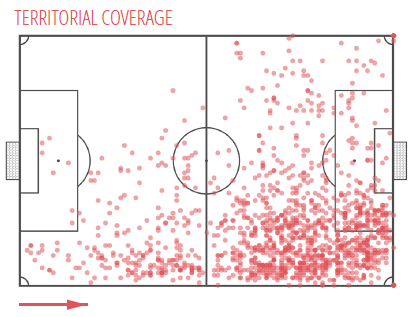
Having played with Norway national youth teams since 2009, Hansen made her debut with the senior team against Belgium in 2011 at the age of seventeen. Within two years she was an impact player in the Norway squad that progressed to the 2013 Euro final (losing to Germany).
In 2014 she signed a contract with Frauen-Bundesliga heavyweights WFL Wolfsburg where she made an immediate impact. Hansen helped Wolfsburg to reach the Champions League finals in both 2016 and 2018 (both loses to Lyon).
In May of 2019, FC Barcelona announced Hansen had signed with the club on a two-year contract. Hansen has made an immediate impact with the club and has helped to elevate Barcelona into an absolute powerhouse in the league.
Dribbling
Hansen is widely seen as a prolific dribbler. Her style is quite reminiscent of Messi in that it is rare for Hansen to use any specific skill moves or tricks to progress the ball. She typically relies on the base concepts of dribbling: Using all parts of both feet to manipulate the ball, change of speed and change of direction. Hansen can execute these concepts at such a high level that it is very difficult to stop her in 1v1 situations.
When observing Hansen, one can also see that she is not afraid to physically outplay the direct opponent. It is not uncommon for Hansen to engage in a sprint against a left-back and use her body to force the defender out of contention for possession in the 1v1 situation.
Hansen, over her career, has taken an average of 10 1v1s per 90′, which is fairly high. The insightful statistic that accompanies that is that she has an astounding 80% success rate in 1v1 dribbles. To give that perspective: Messi (the best dribbler in the world, no arguing) has had a 57.2% success rate in dribbling take-ons since 2006/07.
In Hansen’s first season with Barcelona, she sits 3rd in Primera División dribbles with 11.49 per 90′. It must be noted that out of the top 10 dribblers in the league, she has the highest success rate with 70%.
This high level of dribbling and take-on skill is paired with a highly aggressive mentality when on the ball. Hansen is not afraid to initiate 1v1s, no matter where she is on the pitch.
Below we see an example from a match vs Deportivo de La Coruña. Hansen receives a pass from the centre of the field and receives the ball with her body open to the pitch. In this moment, she is in the middle third of the pitch on the right flank. Upon receiving the ball, the opponent’s left-back is positioned to restrict forward progression.
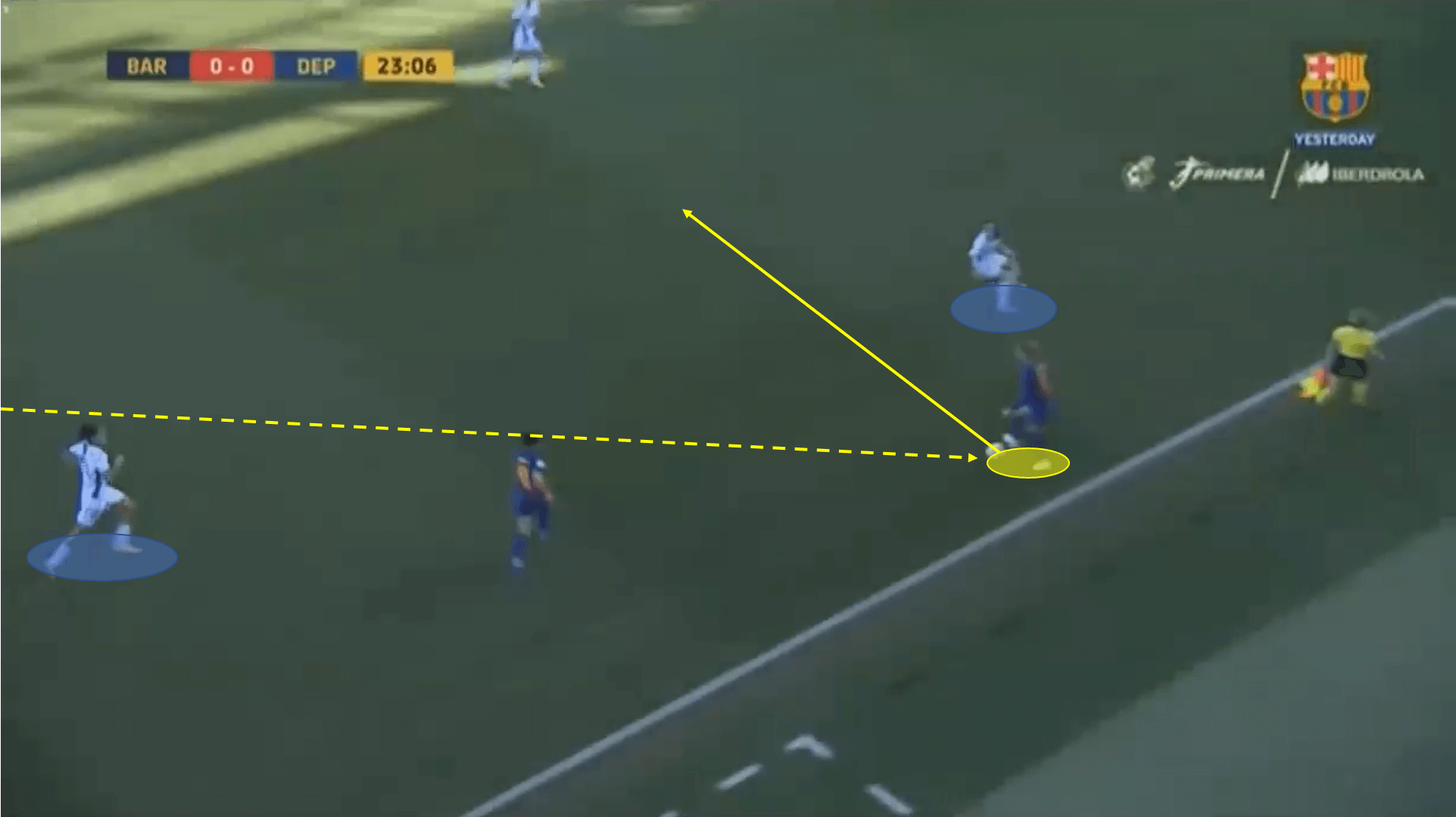
Like-wise, the opponent’s left-midfielder is moving to cover space inside to restrict any lateral dribbling movement. Hansen, who sees that two defenders are restricting her forward and lateral dribbling space, decides to dribble between both players and bypasses both of them within three seconds of receiving the ball.
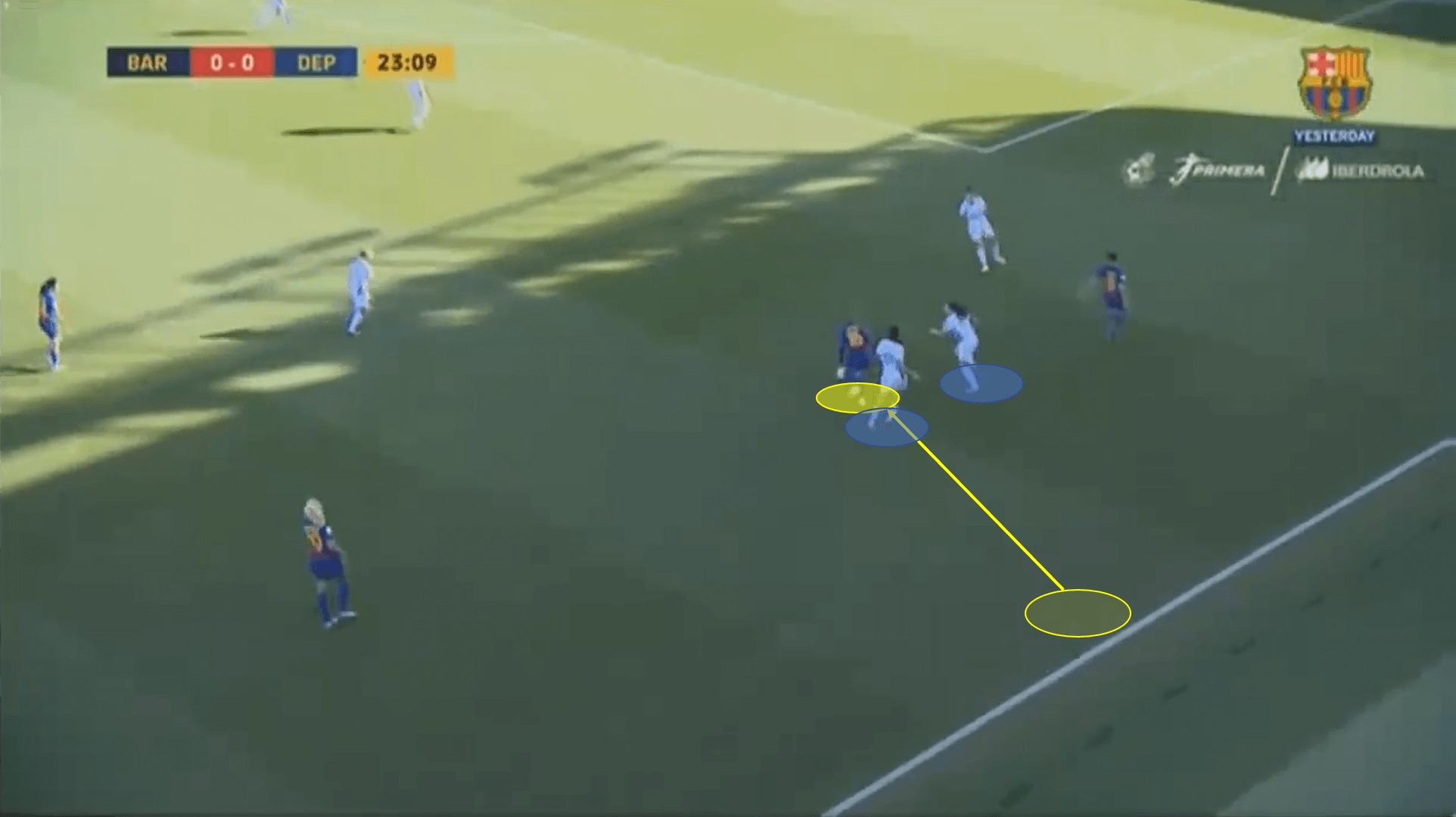
Hansen, with newly found space in front of her, continues her dribble directly at the opponent’s goal. At this point, Deportivo de La Coruña’s centre-midfielder tracks back to stop the advance of Hansen. Simultaneously, two defenders constrict the space between them in an attempt to eliminate the gap Hansen is aiming to penetrate.
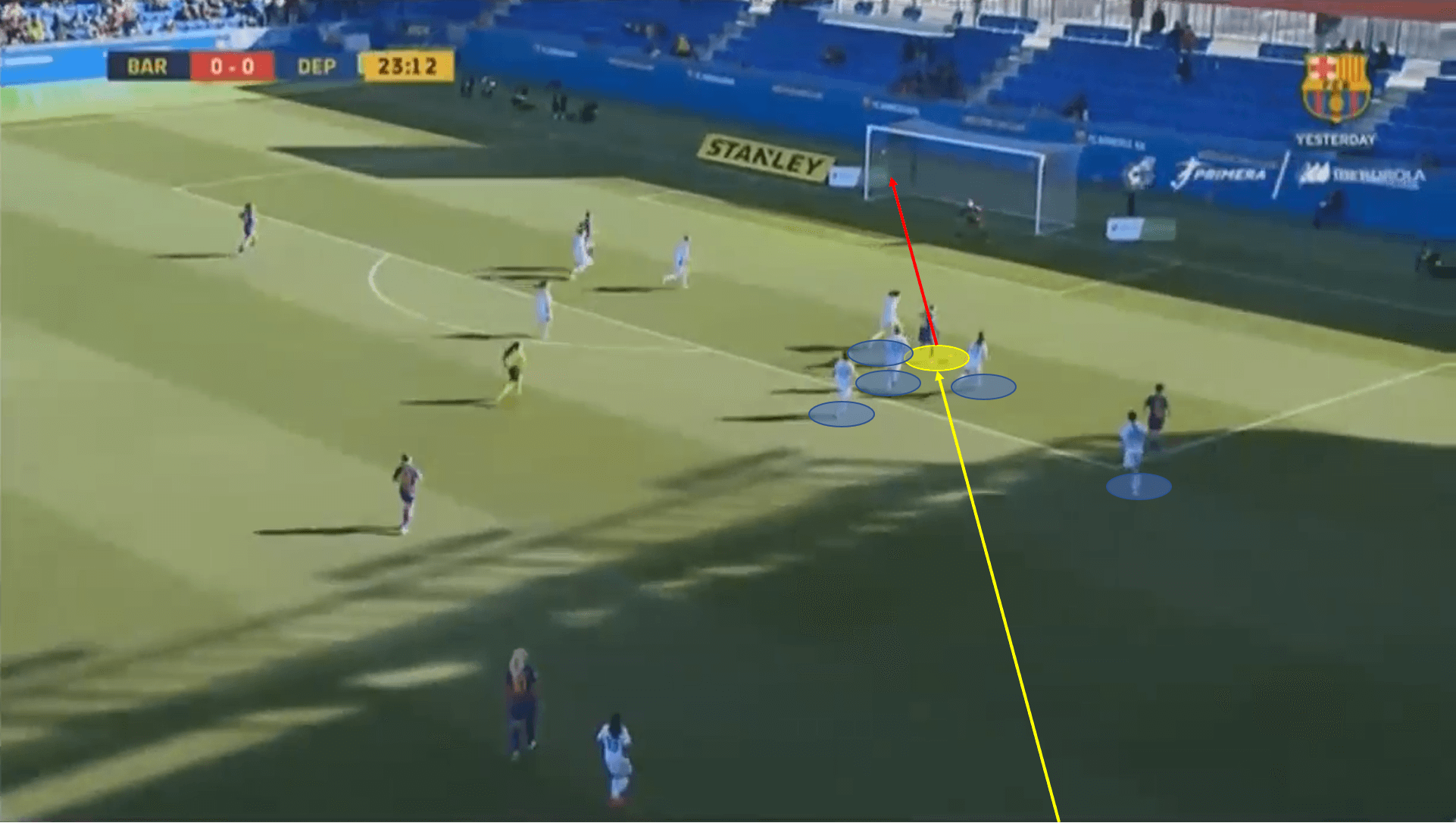
Despite three players closing in on her, Hansen continues her run and rips a shot into the back of the net.
To summarize, Hansen received the ball on the right flank in the middle third, advanced past half of Deportivo de La Coruña’s outfield players and scored the opening goal of the match in six seconds.
Dismarking
Throughout matches, Hansen is not a player who is prone to standing idle and waiting for the ball. In an interview before the 2019 World Cup quarter-final match between Norway and England, Hansen was quoted as saying: “We run a lot and we fight a lot. I don’t think the English players will look forward to play a game against a team running 6km more than them.” Obviously, this is a reference to the Norway national team, but this mentality can be clearly seen in her individual off-the-ball movements in all matches.
When using off-the-ball movement to dismark from a defender, there are a variety of techniques that may be allocated. Hansen typically uses double movements as well as vacating her position to free herself from direct opponent marking.
Double movements, on a basic level, are about moving away from the space that you want to receive the ball in, dragging your marking opponent away, and then quickly moving back into the newly created space. Because this movement is initiated by the attacker, a time-based advantage is formed. The attacker is proactive in creating the movements and has the initiative, while the marking opponent is reactive and naturally at a disadvantage.
Once the attacker has dragged the opponent away from the desired receiving space, a quick movement is initiated. In this split second, the attacker is one or two steps ahead of the opponent as the opponent is currently observing and reacting to the attacker’s movement. The attacker can then move into the desired receiving space unmarked and penetrate forward.
Below, we see a moment in which Hansen has dropped into the midfield line and brought her marking defender with her. Hansen remains stationary until her midfield teammate receives the ball, turns upfield and observes the large amount of space that Hansen has created.
The moment that the midfielder recognises the space to be exploited, Hansen initiates her run. Notice in the image below, that Hansen is in full stride, while the marking opponent is just recognising Hansen’s movement and is adjusting her footing.
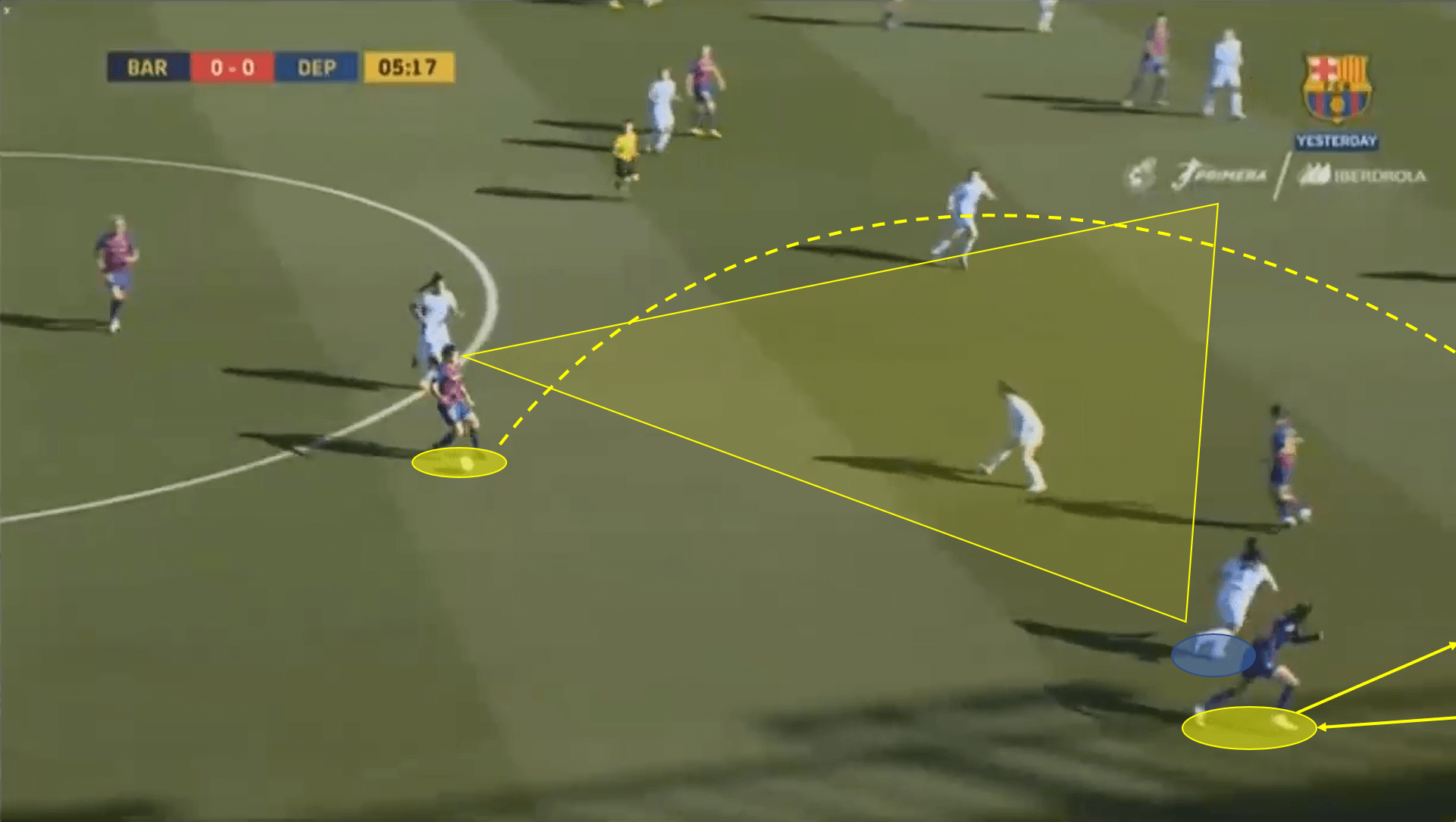
This split-second advantage, paired with Hansen’s natural speed, is all she needs to receive the ball in dangerous attacking space. In this situation, Hansen has removed herself from her marker so much that the marker discontinues attempting to catch Hansen and switches to a recovery run into the box.
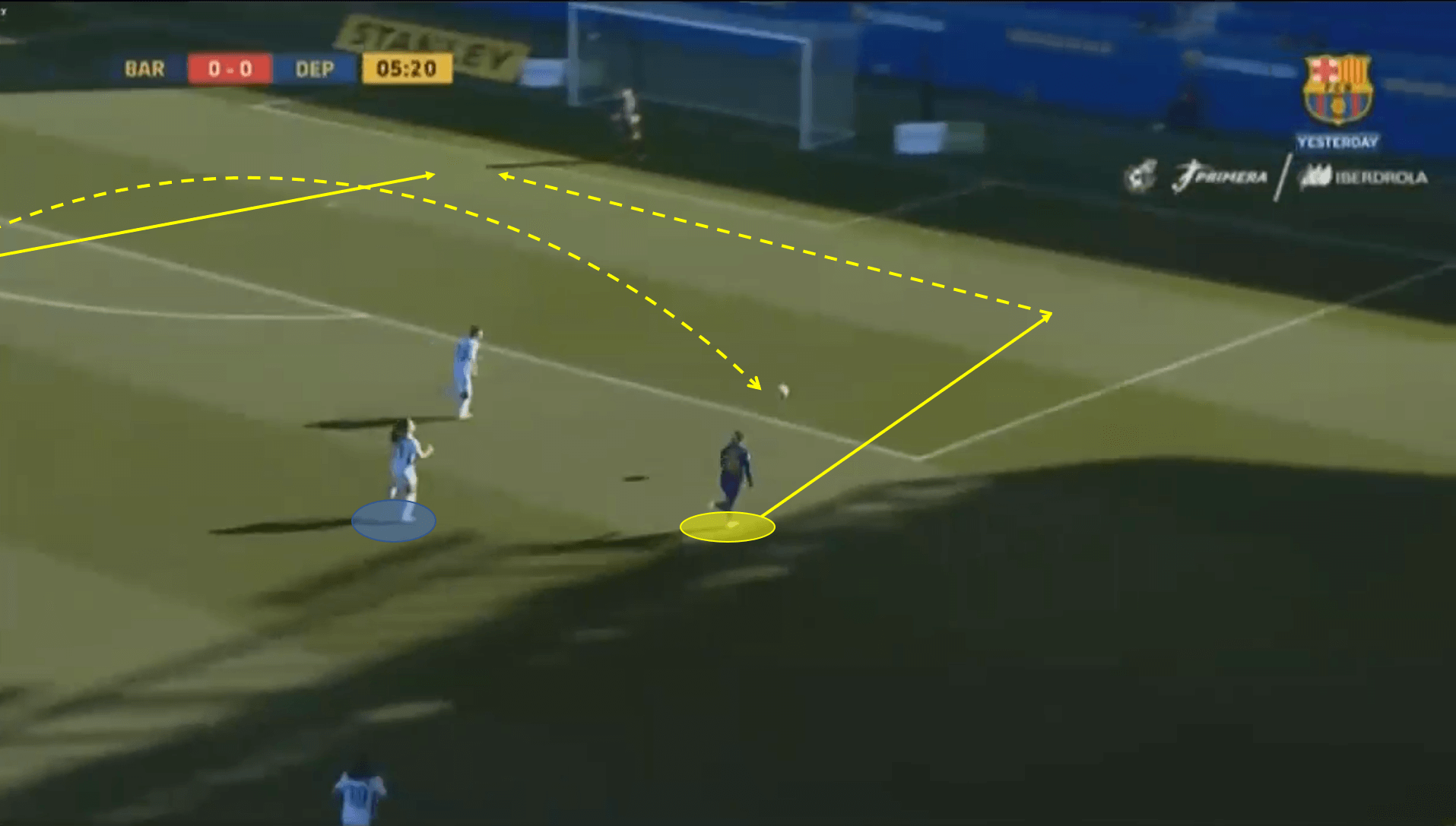
Hansen penetrates forward and lays a low cross just in front of the six-yard box for an oncoming teammate.
Another tool of dismarking that Hansen allocates is the simple vacating of her position on the right-wing. When a right-wing vacates his/her position and drifts across the field, the defender is left with two options. The defender can follow the right-wing and continue to mark tightly, but open a gap in the team defensive structure. Or, the defender can not follow the right-wing, to retain the team defensive structure, but subsequently allow the right-wing to roam free.
Hansen is seen using this dismarking technique in the previously mentioned match. Typically, we find Hansen in the right flank, providing width to the team shape. In the moment below, she has drifted drastically inwards and is almost in the central channel. We can see that the Deportivo de La Coruña left-back has opted not to follow Hansen and has instead chosen to remain a defensive presence in her team’s left halfspace.
Hansen positions herself slightly in front of the defensive line to give herself room to accelerate. Upon the Barcelona midfielder receiving the ball and turning towards the opponent goal, Hansen initiates her run into the large gap between the left-back and centre-back.
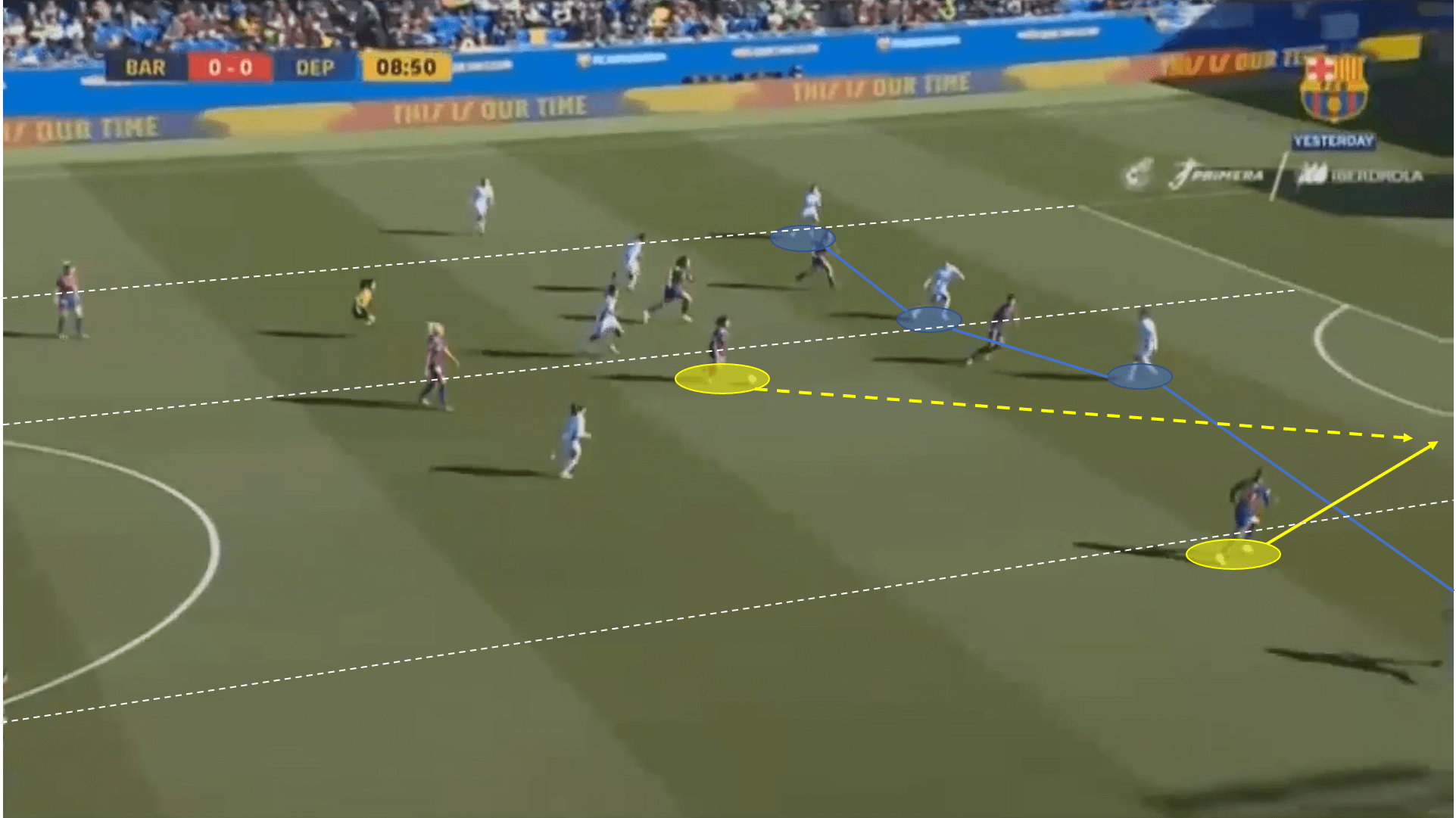
As the ball is played from the Barcelona midfielder, the Deportivo de La Coruña left-back moves to harass and dispossess Hansen. It is too late. Hansen receives the ball in stride, completely unmarked, and rips a shot at the goalkeeper.
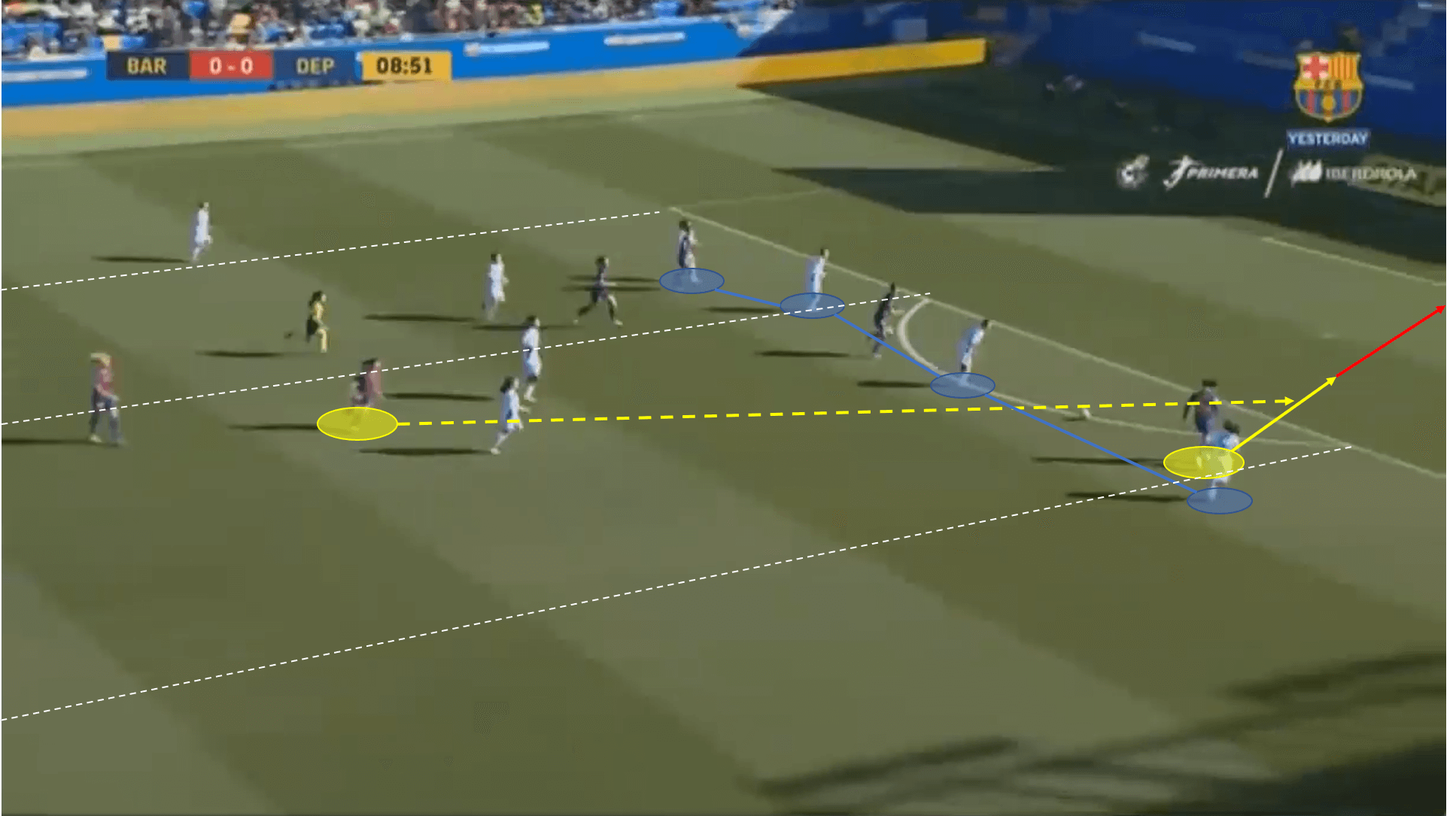
By using two main techniques of individual dismarking, Hansen is consistently able to create and take advantage of the desired space around her. These successful forms of dismarking, paired with her dribbling ability, lead to Hansen having a large influence on Barcelona’s score sheet.
Assists and Goals
Hansen can arguably be called the best chance creator in the Primera División. A few statistics can confirm this. Hansen leads the league in assists and by far has the highest assists per 90’ with 0.78. She also leads the league in key passes with an average of 3.01 per 90’. This is striking considering that Wyscout (where this article’s data is sourced) elaborates on the key pass statistic with “It’s important to show that the player, who made the pass, created a clear goal situation.” This tells us that Hansen is not just hitting mediocre through balls, but creating three scoring chances per full game.
Beyond key passes, we can see that Hansen contributes to goal scoring with crossing and “deep completions” as well. Hansen ranks third in the league in crosses with 7.70 per 90’. She completes crosses with a 33% success rate, which is ranked second out of the top ten crossers in the league.
“Deep completions” can be defined as “a pass (excluding crosses) that was received in a 20-meter radius from the opponent goal line”. We can consider that to be: passes completed in the opponent’s box. Hansen is second in the league in deep completions with 3.23 per 90’.
Below we see an example of Hansen using her dismarking and dribbling ability to create an assist. She has dismarked from her direct opponent to receive the ball and immediately performed a successful 1v1. By combining these two skill sets, she has put herself in a position to penetrate directly into the opponent’s box.
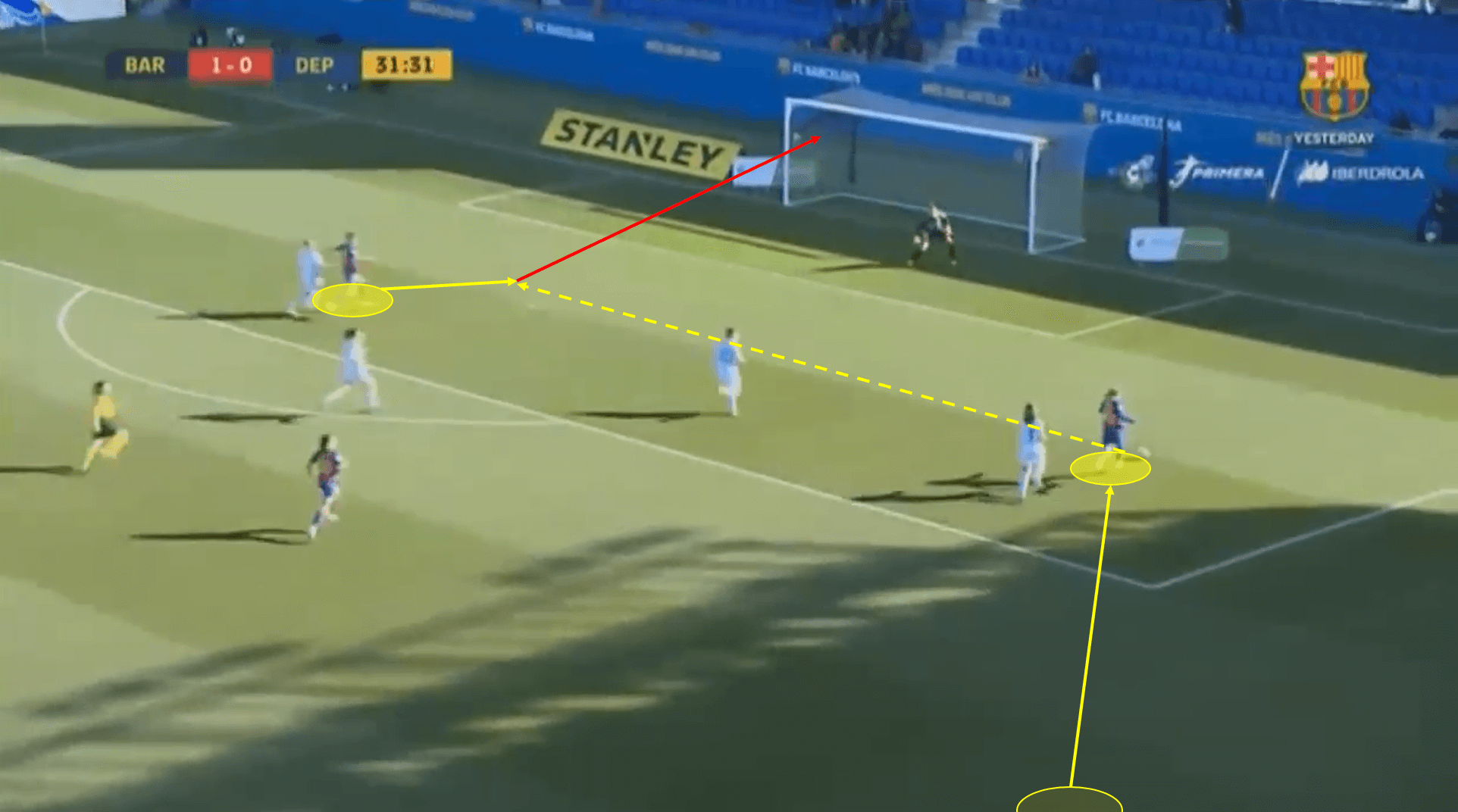
Although she could continue forward and initiate a shot on goal, Hansen recognizes that her teammate has an advantage (positional superiority) over her direct marker. Hansen releases the ball across the ground into the path of her advancing teammate who scores.
Although Hansen is a consistent chance creator, that does not mean that she does not score her share of goals as well. She currently ranks seventh in the league, but with a high per game rate, averaging 0.78 goals per 90’. To provide a frame of reference: Jamie Vardy, who currently leads the 2019/20 Premier League goal-scoring campaign in total goals, is scoring a goal every 117 minutes or 0.77 goals per 90’.
It should be no surprise to look at Hansen’s shot distribution chart below and see that almost a third of her shots come from the right side of the box. These shots are typically performed directly after a 1v1 or after successfully dismarking a defender and receiving the ball in space behind the opposition backline.
We can also see that Hansen is not afraid to take shots from outside of the box and is sometimes prone to vacate her position on the right-wing to create scoring chances from the left side of the field.
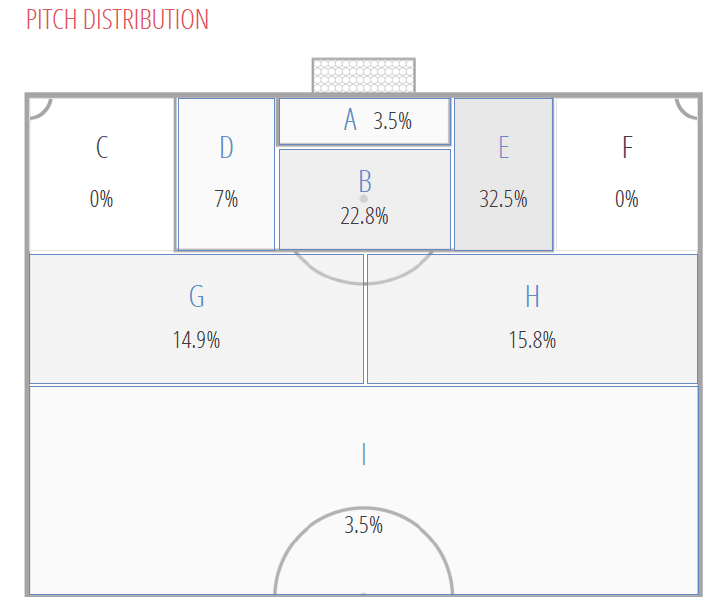
The real statistic that stands out it that Hansen ranks number one in the league in “Touches in the box” with 9.59 per 90’. We can see that Hansen is a constant threat in the opponent’s box and a major source of problems for the defensive backline.
Conclusion
2019/20 is Caroline Hansen’s first step into a different league and debatably a drastically different culture than she is used to playing in. Despite this, she is already performing at an elite level in multiple facets of the game. This raises the question: Is Caroline Graham Hansen going to keep getting better as she settles into the Primera División? For the other fifteen teams in the league, this is indeed a terrifying thought.




Comments